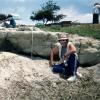| Online: | |
| Visits: | |
| Stories: |
Native American Geometry: The Cure For The Common Core
Native American Geometry: The Cure For The Common Core

INTRODUCING:
The Square’s Square Roots: Pythagorean Landscape Designs
Native American Geometry Workbook 2: 2, by C. Hardaker (M.A.)
“Native American Geometry derives practical mathematical applications from simple artistic designs in a connect-the-dot format. Ages 10 Thru Adult.”
Native American Geometry & The Higher Maths
IF Native Americans did not have 360° circles, a decimal number system, or concepts for irrational numbers and square roots, and no special symbols for √2, √3, Pi, Phi (1.618…) and other proportional constants, then …
How does Native American Geometry contain all of these features and more?
Easy.
They just happen, whether you know about them or not. Proportional constants are built into the system. A 100,000 year old cave man who makes a circle using two stakes and a rope, or a 6-year old who makes a circle with a compass on paper, does not need to know about Pi to make the circle. Or when you make the perfect square, you don’t need to know about √2. These and other proportional constants are present regardless. When students make the shapes as art, you have at your fingertips some very valuable math lessons built into a measurable framework that has become friendly terrain through art.
Square Roots and the Pythagorean Theorem. There is an interesting thing that happens when you make a simple square and other geometric constructions. The things that happen are in the midst of the lines, arcs and intersections that define your design.
The things happen because they are not intentional features when you are drawing the designs. You don’t know they are there until you start looking for them.
The things that happen are the square roots of whole numbers, and in this volume they are isolated by means of Pythagoras’ Theorem. The constructions provide built-in Pythagorean Triplets, in square root form. As the geometry unfolds, you find yourself surrounded by a Pythagorean World.
All it takes is connecting some dots.
Native American Geometry Workbooks:
* program is literally By • The • Dots; intersecting lines and arcs make the dots necessary .
•teaches a new and very practical skill, applicable to the arts and crafts, drafting, architecture, surveying, cartography. Both Indoor/Outdoor Apps, multi-media, multiple intelligences; logic, spatial reasoning, art, symmetry, math, world cultures, student mentors, geometry as a natural phenomenon.
•examines the mathematical consequences of the perfect (regular) polygons. Student art exercises are “warm-ups” for mathematical lessons using their own drawings. For the student and teacher, Native American Geometry is a flawless segue from art to the higher maths.
•the focus is specifically on the regular, equal-sided polygons. Once they are drawn, more complex designs are possible. Students are then introduced to the mathematical consequences of their “art work.”
•the simplest geometric construction, a hexagon for example, contains a wide variety of lower and higher math lessons. Students learn how to draw a perfect hexagon in the first ten minutes, as their first art project. With a little practice comes accuracy; with accuracy, you add a protractor to read the 60° central angles of the hexagon, or you take a calculator to examine what √3 is.
•Grades 5-10, Middle School Math, Adult Education, G.E.D. credit




